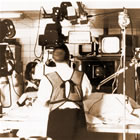
Charles Dotter. MD
Angioplasty was born 55 years ago today when Dr. Charles T. Dotter, a radiologist in Portland, Oregon, performed the first angioplasty. But it wasn’t in the heart; it was in the leg.
An 82-year-old woman was suffering from great pain in her left foot because of blocked circulation in her leg. Her toes had become gangrenous and there was an non-healing ulcer. Amputation was recommended by the physicians at Oregon Health Sciences University, but the woman refused.




 Today being TBT (Throw Back Thursday) on Twitter, Dr. Jordan Safirstein (@CardiacConsult) posted a photo this morning of a poster that appeared 40 years ago at the 1976 American Heart Association meeting. (At the left is our photo of that poster from our history archive.)
Today being TBT (Throw Back Thursday) on Twitter, Dr. Jordan Safirstein (@CardiacConsult) posted a photo this morning of a poster that appeared 40 years ago at the 1976 American Heart Association meeting. (At the left is our photo of that poster from our history archive.)



